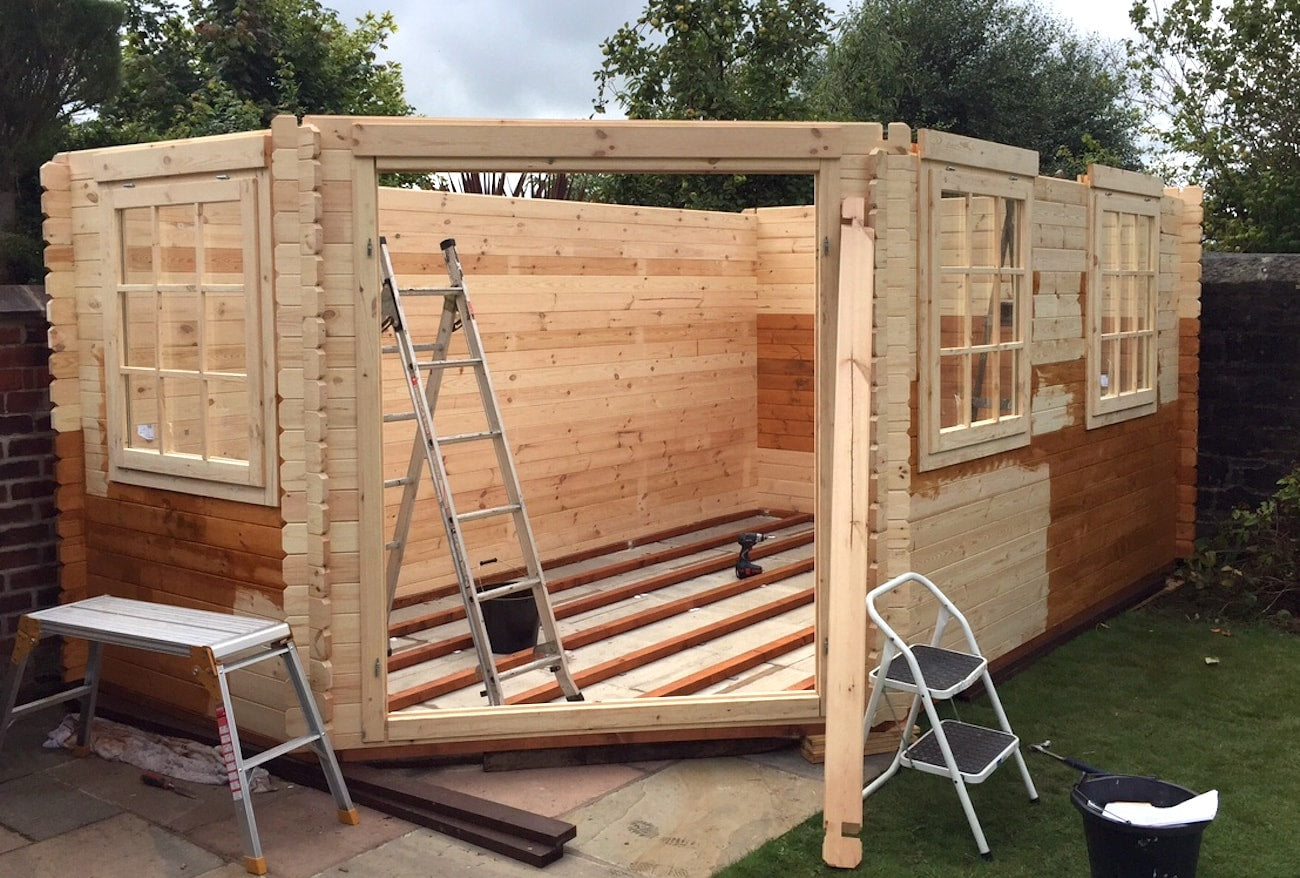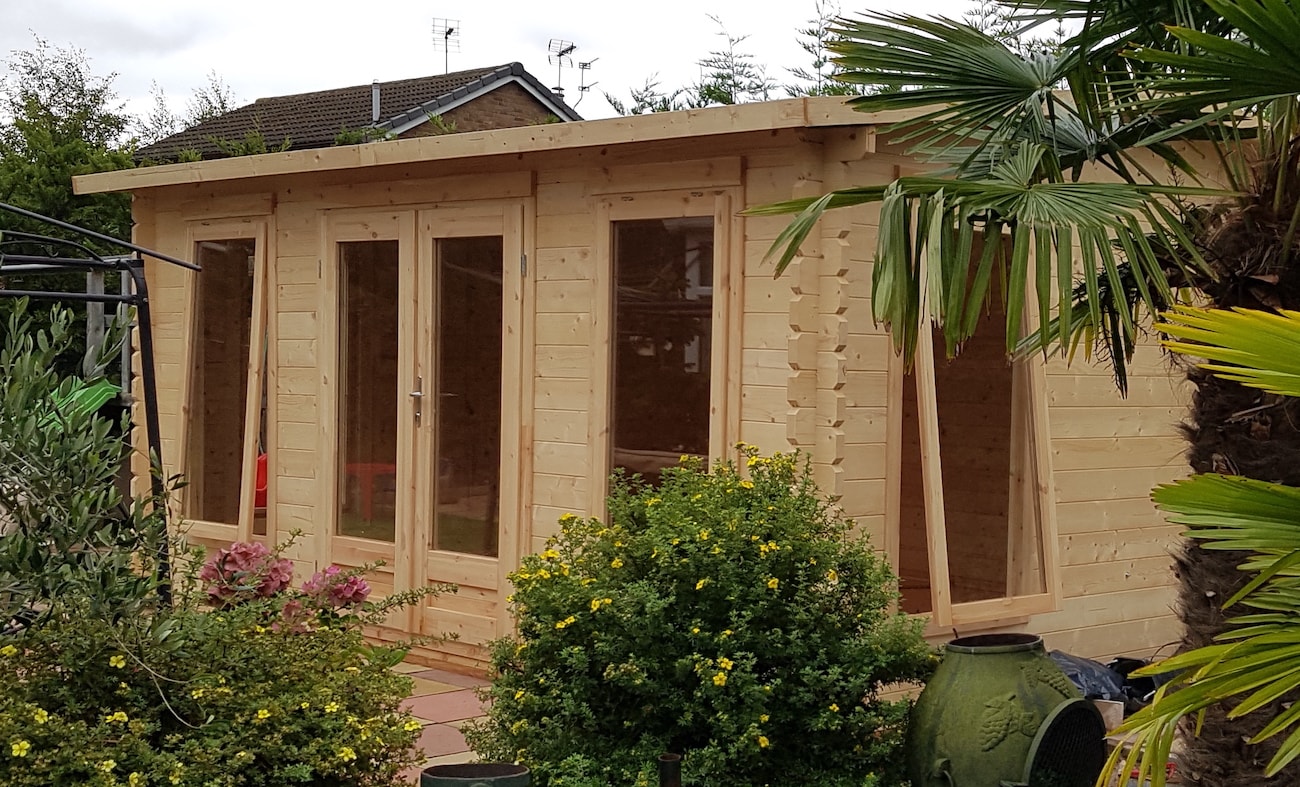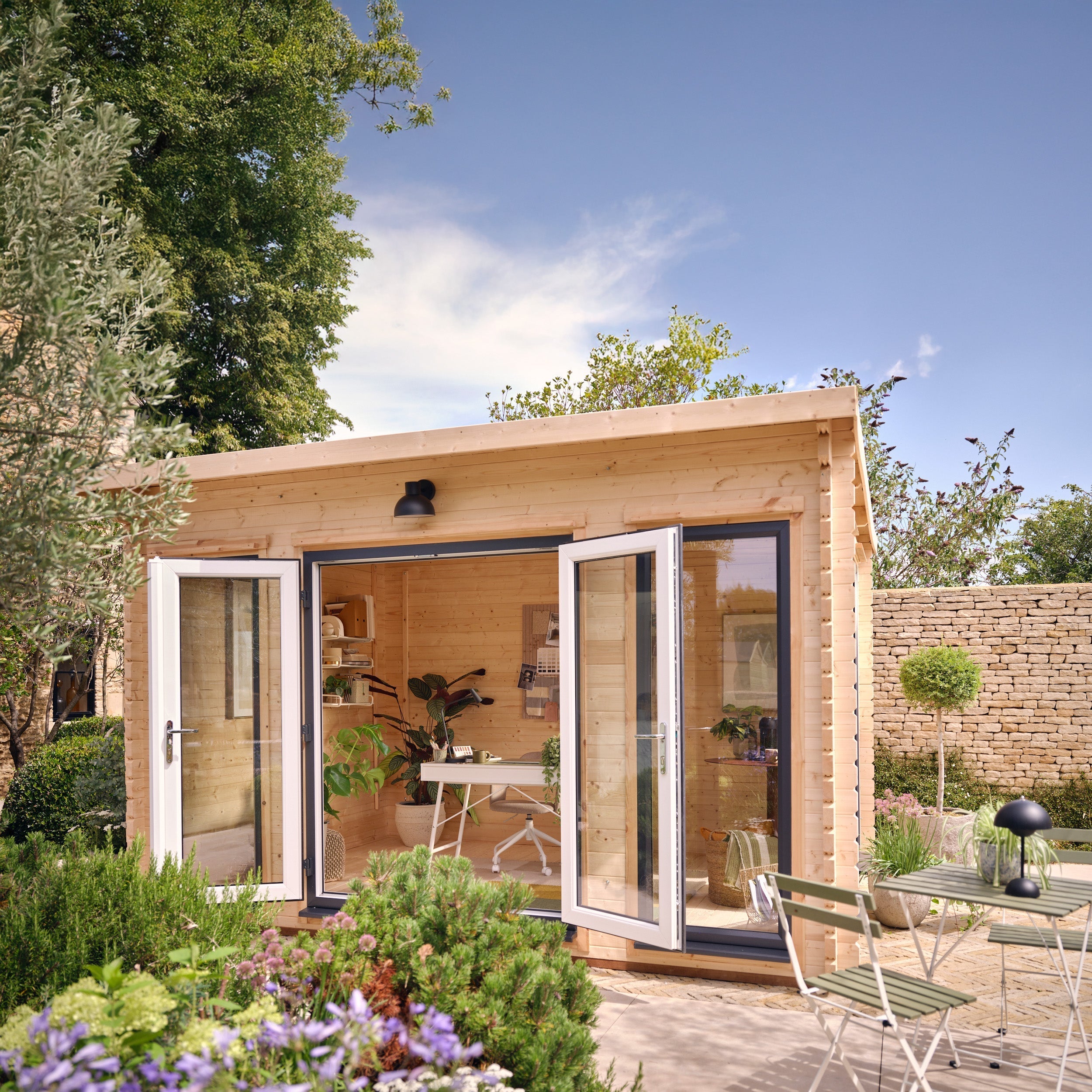A log cabin is the ultimate garden building. So much more than a shed, its robustness, practicality and stunning good looks make it the perfect choice for anyone who’s ever dreamed of owning their own home office, craft workshop, or garden room. If you want a year-round garden bolt hole, entertainment space, or even your very own garden pub, a wooden log cabin is a flexible, affordable way to do it. Here’s how to choose the best log cabin for you.
Types of log cabin
Do you like the traditional look or do you prefer a modern vibe? Are you looking for a small retreat or a larger log cabin for your side hustle? A log cabin can be anything you want it to be – a simple studio, an outdoor dining room, a private gym or a fully functioning workspace. Here are the main options:
Classic

Image: Waltons Sparrow 4m x 3m Log Cabin
For the full Scandinavian look, choose a traditional log cabin with an apex roof and a natural finish. Some cabins also feature an overhanging roof and a veranda.
Modern

Image: Waltons 4m x 3m Wren log cabin
A flat roof, big windows, and double doors combine to produce a streamlined and contemporary log cabin. To make a bold statement, add a block-colour paint finish. Adding extra doors or windows can enhance the modern look and feel of your building.
Mini

Image: Waltons Cuckoo Log Cabin
Starting from 2.4m x 2.4m, a mini log cabin studio is ideal for small spaces. It makes an excellent office, summerhouse, or reading room. Glazed doors and big windows maximize light, making it perfect for limited space or if you want to maximize your remaining outdoor area.
Corner cabin

Image: Waltons Goldcrest 5m x 3m Log Cabin
A corner log cabin is a great space-saver. Fitting neatly into a corner of your garden, they range from a compact 3m x 3m to the large 5m x 3m Goldcrest.
Insulated garden room

Image: 6m x 4m Insulated Garden Room from Waltons
A step up in specification from a regular log cabin, an insulated garden room is ideal for anyone who wants a home office they can use year-round. Double-glazing and double-skinned 72mm thick wall panels with integral insulation keep you warm and cosy on even the coldest days. Work, rest, and play in comfort, any time of the year.
How will you use your log cabin?
Think carefully about what you want to use your log cabin for now and in the future. If you just want storage space then heat and light are less important than if you want a workshop or home office. If you’re looking for a space to relax in, then comfort will be more important. If you’re likely to keep expensive items in your cabin, security is crucial. Some of the main options are as follows:
- Home office – Create a bright and airy space to work in all year round. Choose a cabin with thick timbers, or an insulated garden room, so you can work whatever the weather.
- Guest room – A log cabin makes a great occasional guest room – especially if you install electricity and plumbing. Choose a well-insulated and weather-proofed log cabin.
- Workshop – Having a dedicated workshop at home is the dream of many hobbyists and professionals. A log cabin can be a safe, warm and dry workshop – and some have a useful covered outdoor space too.
- Playroom – Think about safety features like shatterproof styrene glazing, and child locks on windows. Paint your cabin a bright, cheerful colour.
- Hobby room – A corner log cabin is a great option for a cosy, undisturbed space in which to work, craft, read or write, tucked away in a secluded spot in the garden.
- Gym – A log cabin is suitable for a range of leisure uses, including a home gym. Protect the floor with heavy-duty rubber floor tiles, and make sure your cabin is well-ventilated so you don’t overheat.
- Pool house – Got a swimming pool? A log cabin makes a stylish pool house. Double glazing will keep the draughts out.
- Summer house – If you only want to use your log cabin during the summer, you don’t need to go for such thick logs, but you might wish to consider adding a veranda for entertaining, or soaking up the sun.
- Garage – Some log cabins are designed for use as a garage. Go for one with a large footprint and high ceiling, so that you can use it as a workshop or hobby space too.
Size and layout
Your intended use will help you decide what size log cabin you need. It’s also a good idea to think about how many people will use it at once – how many people will be visiting your garden pub, or how big a party do you want to entertain in your log cabin? Layout options to maximise space include:
- Veranda – add a veranda with an overhanging apex roof to create outside entertaining space.
- Multi-room – some cabins can be divided into more than one room – ideal if you need a meeting space.
- Storage – some cabins have adjoining storage space – great for keeping your shed contents separate from your garden room.
You might put your cabin to more than one use, for example, a home office that you can also use as an occasional guest room.
A log cabin should be big enough to evolve with your family’s needs – a children’s playroom might need to become a hangout for teens before it can morph into the craft room you’ve always dreamed of.
Pick a cabin that fits your lifestyle now, but which will adapt to future uses, and you’ll be happy with your choice for years to come.
Check out the full range of log cabins
Where to site your log cabin
Most garden buildings like log cabins don’t require planning permission, but there are exceptions, including if your house is a listed building or is on designated land – like an Area of Outstanding Natural Beauty. You’ll also need to seek planning permission and comply with building regulations if you plan to connect your log cabin to mains electricity. For more details see the UK Government’s Planning Portal website and check out our comprehensive Guide to Garden Planning Permission.
To help visualise how your log cabin will sit within your garden, use tent pegs or canes to mark out its dimensions. Pick a location suited to its intended use, and consider the following:
- Light – If you need lots of natural light, avoid a shady spot, and try to make your windows south-facing.
- Heat – If you’re worried about overheating, keep your windows in a shady area (but avoid overhanging branches). If you want to maximise warmth, pick a sunny spot.
- Utilities – if you need water and/or electricity, think about the location of the mains supplies when siting your cabin.
Getting the details right

Image: 4m x 3m Wren Log Cabin from Waltons
1. How to choose the right base
Log cabins are heavier than your average garden shed – especially if you go for thicker logs – so a wooden base isn’t appropriate. A paving slab base is fine for a small cabin, but concrete offers a stronger, more permanent foundation.
For more information about building a base for your log cabin, read our guide on How to build a concrete base. If you’re unsure, always call in the professionals. Check out the table below for some of the pros and cons of each base type. Higher numbers are better.
Features |
Paving Slabs |
Concrete |
 |
 |
|
| Description | Stone or concrete paving slabs on a hardcore and mortar base | Single slab of concrete, poured to the dimensions required |
| Recommended use | Larger sheds, summerhouses and log cabins. Often used as a larger space for a shed and patio area. | Sheds that need the strongest and most stable base, such as large sheds, log cabins and garden rooms. |
| Durability | ★★★★☆ | ★★★★★ |
| Damp protection | ★★★★★ | ★★★★★ |
| Build Time | ★★★☆☆ | ★★★☆☆ |
| Cost | ★★★★☆ | ★★★☆☆ |
Check out the full range of log cabins
2. How to choose the right materials
The logs used to construct a log cabin are precision cut and slot together as the cabin is built. The shape of the joint creates a really tight fit; needing no fixings, but giving maximum weather resilience.
The logs are also kiln-dried which, because it extracts moisture from the timber, reduces the risk of splitting and warping. But because timber is a natural material, changes in the moisture content due to the weather may still create some movement.
The timber that’s used should always be slow-grown, and from a sustainable source. You can tell if it’s slow-grown by the width of the growth rings at the edge of the logs – the narrower they are, the slower the tree grew. Look out for the certification which guarantees that the wood is from a well-managed and sustainable forest.
Log cabins are available in various wall or log thicknesses: 19mm, 28mm, 34mm, or 44mm. A cabin built with thicker logs will be more robust and better insulated:
- 19mm or 28mm is fine if you plan only to use your building on summer days.
- 34mm is suitable for summer evenings or spring days.
- 44mm is ideal for year-round use. Invest in double-glazing for extra insulation.
3. Windows
Double glazed, toughened windows are included as standard in Waltons Log Cabins, however the size and amount of windows you require should be considered. Choose windows according to how you plan to use your building. Half windows let in a considerable amount of light while also offering plenty of privacy. Full length windows let light flood the interior and provide unobstructed views of your garden - perfect for if you need to keep an eye on the kids.
Window bars are purely decorative and don’t offer any specific function. Add them for a vintage appearance, or leave them off for a more contemporary look and an uninterrupted view of your garden.
4. Doors
Your log cabin will come with a door, or set of double doors, as standard. The main types of doors on log cabins are:
- Framed single door – Used in houses, this is the most secure option. Solid, glazed or part-glazed, this is the type of door most commonly found on a log cabin. Particularly suitable for home offices, due to the higher security it offers.
- Framed double doors – Offering easy access for moving large pieces of furniture in or out, framed double doors also let in extra light, effectively providing another window. Many single-door log cabins can be upgraded to double door.
Whether you choose single or double doors, Waltons log cabins’ doors are supplied with secure mortice locks to help keep your belongings safe and sound.
UPVC upgrade

UPVC anthracite grey door
Image: Waltons Wren Pent Log Cabin with UPVC
Upgrade your windows and doors with UPVC, a low maintenance material popular for its finished looks and durability. UPVC is lightweight, strong and extremely energy efficient, meaning your log cabin will retain heat during the cooler months. Our UPVC upgrade is available for all 44mm log cabins and comes in three attractive colours - white, oak and anthracite grey.
Check out our full range of Log Cabins with UPVC
5. Roof types
You might decide to choose the roof style you most like the look of, but you should also consider:
- Height: At the entrance and inside, for yourself and anything you want to store.
- Planning permission: There may be a height restriction depending on where you live or the position of your shed relative to your house. See Waltons’ guide to planning permission.
The choices of roof style available for your log cabin are apex, pent and curved:
Conventional apex roof style

Image: Waltons Value 19mm Log Cabin
The most traditional look, this is an 'A'-shaped sloping roof. It provides plenty of headroom and sheds water very effectively.
Modern pent roof design

Image: Waltons Value 19mm Pent Log Cabin
Another single flat panel roof, but with a steeper gradient for rainwater to run off.
Curved Roof

A curved roof adds a stylish flair to your garden
Image: Waltons 4m x 3m Tawny Log Cabin
Not only does a curved roof ensure sufficient rainwater run off but it also adds a unique feature to any garden.
6. Roof coverings
Although a log cabin’s tongue and groove roof is watertight, there’s always a risk that the natural movement of the timbers may allow water to penetrate over time. There are a number of different coverings available. The table below summarises your options:
Superior duty roof felt |
EPDM |
|
 |
 |
|
| Description | Glass fiber with bitumen base. Easy to fit and maintain. 50% thicker than standard felt. | Tough, synthetic rubber. Best fitted by an experienced DIYer or a professional. |
| Recommended use | For cabins in exposed locations or those where a longer roof lifespan is essential | The toughest, longest-lasting roof covering |
| Cost | Under £80 for a 3m x 3m cabin | Around £130 for a 3m x 3m cabin. Other materials may be required |
| Lifespan | 5-10 years. Check annually | Over 30 years |
7. Floors and ceilings
The roof and floors of cabins should be built from kiln-dried tongue and groove boards, which lock together to give a smooth, watertight finish. Roof boards should be 12mm or more thick, but floor thickness varies depending on which cabin you opt for. Under the floor, the floor-bearers or joists are made from pressure-treated timber beams that run the full length of the log cabin. They support the base of the building and raise it off the floor, protecting it from groundwater and rising damp.
8. Utilities
It can be useful to have a supply of electricity and/or water to your log cabin, particularly if you use it as an office, an art studio or an occasional guest room. See our guides to getting power and water to your garden building. Always make sure you comply with building regulations, and call in the professionals to do the work. If it isn’t practical to install mains utilities to your cabin, you could always look into off-grid power options such as solar or wind power.
Log cabin care

Customer image: Paul Norris
Assembly
There will be some construction required when you receive your log cabin so do check our How to Build a Log Cabin guide. Alternatively, our team can assemble it for you on delivery. Give us a call to find out what your options are. If you opt for one of our premium log cabins, professional installation is included in the purchase price. Finally, be sure to use professionals for electricity and plumbing to make sure your project conforms to building regulations.
Wood treatments
Log cabins are supplied untreated, so should always be treated with a quality wood preservative within two weeks of construction. See our maintenance guide for inspiration.
Security
No garden building is 100% secure. To help to keep your valuables safe from thieves, pay attention to the following:
- Garden – Most thieves are opportunists, so make your garden difficult for them to access.
- Door – Your log cabin will have a sturdy door fitted with a mortice lock. You might also reinforce the door with sheet metal, especially the area behind the lock.
- Windows – Toughened glass won’t smash if someone hits it with a hammer or brick. Window locks and security shutters add further layers of security.
- Concealment – Use curtains or blinds, and store valuables out of sight. If you use your cabin as a home office, keep filing cabinets locked and don’t leave computers in your cabin overnight – use a portable laptop. Secure valuables such as TVs to the floor or wall.
- Lock – A mortice lock is fairly secure, but you can add more, like a Yale lock. But beware of using many locks which may advertise the presence of valuables.
- Alarm – Wire your shed or workshop into your home burglar alarm, or install an independent system.
More help
You should now have an idea of the size and type of log cabin you need, and the options and upgrades available when you want to buy. For more help. call our friendly, helpful sales experts on 01636 821 135.

Customer image: Grahame Bland
Additional resources:
- Find out how to build a base for your log cabin here: how to build a shed base.
- Find out if you need planning permission here: Guide to Planning Permission
- Waltons help pages
- Waltons blog
Browse our full range of wooden log cabins, insulated garden rooms, playhouses, summer houses and sheds by visiting waltons.co.uk.



Share:
Waltons' Ultimate Shed Buying Guide
Waltons’ ultimate guide to buying a greenhouse